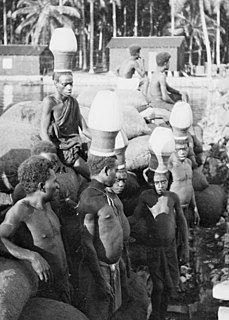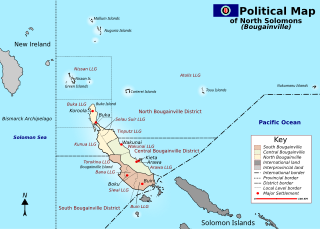
Papua New Guinea, officially the Independent State of Papua New Guinea, is a country in Oceania that comprises the eastern half of the island of New Guinea and its offshore islands in Melanesia. Its capital, located along its southeastern coast, is Port Moresby. The country is the world's third largest island country, with an area of 462,840 km2 (178,700 sq mi).

Bougainville, officially the Autonomous Region of Bougainville, is an autonomous region in Papua New Guinea. The largest island is Bougainville Island, while the region also includes Buka Island and a number of outlying islands and atolls. The interim capital is Buka, although this is considered temporary, with the capital likely to move. One potential location is Arawa, the previous capital.

Bougainville Island is the main island of the Autonomous Region of Bougainville, which is part of Papua New Guinea. It was previously the main landmass in the German Empire-associated North Solomons. Its land area is 9,300 km2 (3,600 sq mi). The population of the whole province, including nearby islets such as the Carterets, is approximately 300,000. The highest point is Mount Balbi, on the main island, at 2,715 m (8,907 ft). The much smaller Buka Island, c. 500 km2 (190 sq mi), lies to the north, across the 400–500 m (1,300–1,600 ft) wide Buka Strait. Even though the strait is narrow, there is no bridge across it, but there is a regular ferry service between the key settlements on either side. The main airport in the north is in the town of Buka.
"O Arise, All You Sons" is the national anthem of Papua New Guinea. Adopted in 1975, it was written and composed by Thomas Shacklady.

For administrative purposes, Papua New Guinea is divided into administrative divisions called provinces. There are 22 provincial-level divisions, which include 20 provinces, the Autonomous Region of Bougainville, and the National Capital District of Port Moresby.

Bougainville, an autonomous region of Papua New Guinea (PNG), has been inhabited by humans for at least 29,000 years, according to artefacts found in Kilu Cave on Buka Island. The region is named after Bougainville Island, the largest island of the Solomon Islands archipelago, but also contains a number of smaller islands.
Bougainville Copper Limited (BCL) is a mining company of Papua New Guinea (PNG) that is listed on the Australian Securities Exchange (ASX). BCL operated the copper, gold and silver mine at the Panguna mine on Bougainville Island in PNG from 1971 to 1989. Mining operations were officially halted on 15 May 1989, due to militant activity and the mine has remained closed since.
The Bougainville People's Congress was a pro-independence organisation and later political party in the Autonomous Region of Bougainville, Papua New Guinea.

The Flag of Bougainville is a symbol of the Autonomous Region of Bougainville in Papua New Guinea. It was originally adopted in 1975 by the secessionist Republic of North Solomons.

The national emblem of Papua New Guinea consists of a bird-of-paradise over a traditional spear and a kundu drum. Designed by Hal Holman, an Australian artist working for the Papuan government, Holman was also involved in the design of the National flag. Both the emblem and the flag was accepted by the House of Assembly of Papua and New Guinea and signed into law as the National Identity Ordinance by the Administrator Sir Leslie Johnson on 24 June 1971. The ordinance came into effect after its publication in the Papua New Guinea Gazette of 1 July 1971.
For administrative purposes, Papua New Guinea (PNG) is divided into administrative divisions called regions and provinces. Papua New Guinea is divided into four regions and 22 province-level divisions: 20 provinces plus the autonomous region (Bougainville) and the National Capital District.

The Autonomous Bougainville Government is the government of the Autonomous Region of Bougainville, Papua New Guinea.

The Republic of the North Solomons was an unrecognised state that purported to exist for about six months in what is now the Autonomous Region of Bougainville, Papua New Guinea (PNG). It involved:
a 'Unilateral Declaration of Independence of the Republic of North Solomons' and a failed bid for self-determination at the UN

The President of the Autonomous Region of Bougainville governs the island, which is an autonomous entity within Papua New Guinea.

The Bougainville House of Representatives is the legislature of the Autonomous Region of Bougainville, an autonomous entity within Papua New Guinea. It was established in 2005 under Part 5 of the region's constitution, which specifies that the House of Representatives shall comprise 39 elected members in addition to the President of the Autonomous Region of Bougainville, and the Speaker of the House, chosen outside of it.

The upe is a traditional headdress worn by men in parts of Bougainville to symbolise their transition to adulthood. The term is also used to refer to the process of undergoing the transition and to the initiates themselves.

The Bougainville conflict, also known as the Bougainville Civil War, was a multi-layered armed conflict fought from 1988 to 1998 in the North Solomons Province of Papua New Guinea (PNG) between PNG and the secessionist forces of the Bougainville Revolutionary Army (BRA), and between the BRA and other armed groups on Bougainville. The conflict was described by Bougainvillean President John Momis as the largest conflict in Oceania since the end of World War II in 1945, with an estimated 15,000–20,000 Bougainvilleans dead, although lower estimates place the toll at around 1,000–2,000.

A non-binding independence referendum was held in Bougainville, an autonomous region of Papua New Guinea, between 23 November and 7 December 2019. The referendum question was a choice between greater autonomy within Papua New Guinea and full independence; voters voted overwhelmingly (98.31%) for independence.

My Bougainville is the anthem of the Autonomous Region of Bougainville in Papua New Guinea. The anthem was officially adopted in 2018. It is sung to the tune of "The Song of Australia", the melody of which was composed by Carl Linger.

The COVID-19 pandemic in the Autonomous Region of Bougainville is part of the ongoing worldwide pandemic of coronavirus disease 2019 caused by severe acute respiratory syndrome coronavirus 2. The Autonomous Region of Bougainville's confirmed its first case of the COVID-19 pandemic on Friday, August 7, 2020, in Arawa, Bougainville. The first documented arrival of COVID-19 in Bougainville occurred just before the start of the Bougainvillean general and presidential elections, which took place over the course of three weeks beginning on August 12, 2020, and ending on September 1, 2020.









